Little in the literature helps us identify programs that are successful in achieving lasting reunification of children in out-of-home care with their families. Much of the research has looked at characteristics of children and families that help or hinder reunification, but not at whether children are able to remain in their homes over time, or what their long-term outcomes are in safety and well-being (Littell & Schuerman, 1995; Maluccio, 1998; Wulczyn, 2004).
The U.S. National Resource Center for Foster Care and Permanency Planning (NRCFCPP) has worked with some programs that seem to be moving toward faster, safer and lasting reunifications. However, as there is little research to prove that these programs actually do work, we have chosen to highlight several practices we believe are important components of reunification programs that appear to be achieving good results. These practices are:
-
placement decision-making;
-
parent-child visiting;
-
intensive services;
-
resource parent/birth parent collaboration; and
-
aftercare services.
These are by no means the only practices that should be incorporated into a reunification program, nor do they provide a guarantee of success when used individually or in combination. Rather, they represent some of the important building blocks on which a comprehensive system of reunification can be based.
©The National Resource Center for Foster Care & Permanency Planning / Hunter College School of Social Work

